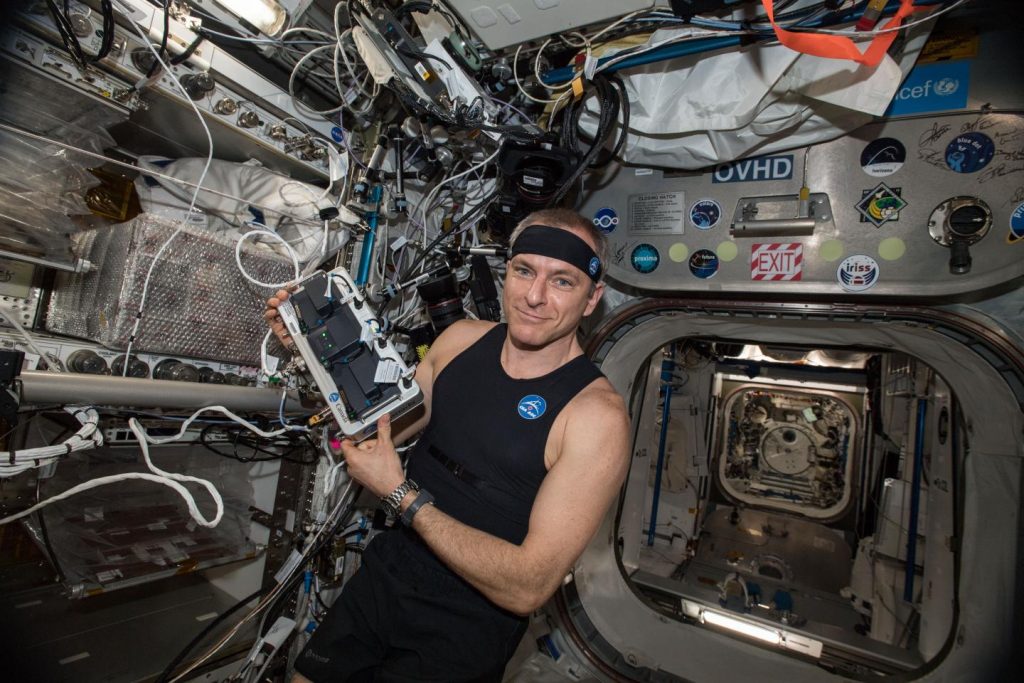
Here’s a biosensor announcement from an April 27, 2021 Experimental Biology (annual meeting) news release on EurekAlert,
A technology-packed tank top offers a simple, effective way to track astronauts’ vital signs and physiological changes during spaceflight, according to research being presented at the American Physiological Society annual meeting during the Experimental Biology (EB) 2021 meeting, held virtually April 27-30.
By monitoring key health markers over long periods of time with one non-intrusive device, researchers say the garment can help improve understanding of how spaceflight affects the body.
“Until now, the heart rate and activity levels of astronauts were monitored by separate devices,” said Carmelo Mastrandrea, PhD, a postdoctoral fellow at the Schlegel-University of Waterloo Research Institute for Aging in Canada, and the study’s first author. “The Bio-Monitor shirt allows simultaneous and continuous direct measurements of heart rate, breathing rate, oxygen saturation in the blood, physical activity and skin temperature, and provides a continuous estimate of arterial systolic blood pressure.”
The Bio-Monitor shirt was developed for the Canadian Space Agency by Carré Technologies based on its commercially available Hexoskin garment. In a study funded by the Canadian Space Agency, a team of researchers from the Schlegel-University of Waterloo Research Institute for Aging oversaw the first test of the shirt in space for a scientific purpose. Astronauts wore the shirt continually for 72 hours before their spaceflight and 72 hours during spaceflight, except for periods of water immersion or when the device conflicted with another activity.
The shirt’s sensors and accelerometer performed well, providing consistent results and a large amount of usable data. Based on these initial results, researchers say the shirt represents an improvement over conventional methods for monitoring astronauts’ health, which require more hands-on attention.
“By monitoring continuously and non-intrusively, we remove the psychological impacts of defined testing periods from astronaut measurements,” said Mastrandrea. “Additionally, we are able to gather information during normal activities over several days, including during daily activities and sleep, something that traditional testing cannot achieve.”
In flight, the astronauts recorded far less physical activity than the two and a half hours per day recorded in the monitoring period before takeoff, a finding that aligns with previous studies showing large reductions in physical activity during spaceflight. In addition to monitoring astronauts’ health and physical activity in space, Mastrandrea noted that the shirt could provide early warning of any health problems that occur as their bodies re-adapt to gravity back on Earth.
The commercial version of the Bio-Monitor shirt is available to the public, where it can be used for various applications including assessing athletic performance and monitoring the health of people with limited mobility. In addition to spaceflight, researchers are examining its potential use in other occupational settings that involve extreme environments, such as firefighting.
Mastrandrea will present this research in poster R2888 (abstract). Contact the media team for more information or to obtain a free press pass to access the virtual meeting.
###
About Experimental Biology 2021
Experimental Biology is an annual meeting comprised of thousands of scientists from five host societies and multiple guest societies. With a mission to share the newest scientific concepts and research findings shaping clinical advances, the meeting offers an unparalleled opportunity for exchange among scientists from across the U.S. and the world who represent dozens of scientific areas, from laboratory to translational to clinical research. http://www.experimentalbiology.org #expbio
About the American Physiological Society (APS)
Physiology is a broad area of scientific inquiry that focuses on how molecules, cells, tissues and organs function in health and disease. The American Physiological Society connects a global, multidisciplinary community of more than 10,000 biomedical scientists and educators as part of its mission to advance scientific discovery, understand life and improve health. The Society drives collaboration and spotlights scientific discoveries through its 16 scholarly journals and programming that support researchers and educators in their work. http://www.physiology.org
Mastrandrea’s abstract offers details explaining what makes this particular biosensor a new technology (from the ‘(R2888) Tracking astronaut physical activity and cardiorespiratory responses with the Bio-Monitor sensor shirt‘ abstract at the Experimental Biology (EB) 2021 meeting,
Carmelo Mastrandrea (Schlegel-UW Research Institute for Aging)| Danielle Greaves (Schlegel-UW Research Institute for Aging)| Richard Hughson (Schlegel-UW Research Institute for Aging)
Astronauts develop insulin resistance, and are at risk for cardiovascular deconditioning, during long-duration missions to the International Space Station (ISS) despite their daily exercise sessions (Hughson et al. Am J Physiol Heart Circ Physiol 310: H628–H638, 2016). Chronic unloading of the musculoskeletal and cardiovascular systems in microgravity dramatically reduces the challenge of daily activities, and the astronauts’ schedules limit them to approximately 30-min/day aerobic exercise. To understand the physical demands of spaceflight and how these change from daily life on Earth, the Vascular Aging experiment is equipping astronauts for 48-72h continuous recordings with the Canadian Space Agency’s Bio-Monitor wearable sensor shirt. The Bio-Monitor (Bio-M), developed from the commercial Hexoskin® device, consists of 3-lead ECG, thoracic and abdominal respiratory bands, 3-axis accelerometer, skin temperature and SpO2 sensor placed on the forehead. Our utilisation of this equipment necessitated the development of novel processing and visualisation techniques, to better interpret and guide subsequent data analyses [emphasis mine]. Here we present initial data from astronauts wearing the BioM prior to launch and aboard the ISS, demonstrating the ability to extract useful data from BioM, using software developed ‘in-house’.
Astronauts wore the Bio-M continually for 72-h except for periods of water immersion or when the device conflicted with another activity. After physical exercise, astronauts changed to a dry shirt. First, we assessed the key data-quality metrics to provide initial appraisals of acceptable recordings. Mean total recording length pre-flight (60.5 hours) was similar to that in-flight (66.5 hours), with a consistent distribution of recorded day (44% vs 45%, 6am-6pm) and night (56% vs 55%, 6pm-6am) hours (pre-flight vs in-flight respectively).
For each recording, quality assessment of ECG signals was performed for individual leads, before combining signals and cross-correlating R-waves to produce reliable heart-rate timings. Mean ECG quality for individual leads, represented here as the percentage of usable signal to total recording duration, was somewhat lower in-flight (92%) when compared to pre-flight (96%), likely caused by poor skin contact or dry shirt electrodes; combining lead signals as mentioned above improved the proportion of usable data to 97% and 98% respectively. Accelerometer recordings identified a significant reduction in high-force movements over the 72-hour recordings, with just over 2.5 hours/day of high-force activity in astronauts pre-flight vs 50 minutes/day in-flight. It should be noted however that accelerometer measurements in zero-gravity are likely to be reduced, and future refinement of activity data continues. Average heart rates in-flight showed little difference when compared to pre-flight, although future analyses will compare periods of sleep, rest, and activity to further refine this comparison.
We conclude that utilisation of the BioM hardware with our own analysis techniques produces high-quality data allowing for future interpretation and investigation of spaceflight-induced physiological adaptations.
As for Hexoskin (Carré Technologies inc.), I found out more on the About Us webpage of the Hexoskin website (Note: Links have been removed),
Hexoskin (Carré Technologies inc.)
Founded in 2006 in Montreal [Canada], Hexoskin is a growing private company, leader in non-invasive sensors, software, data science & AI services. The company headquartered in the bustling Rosemont neighborhood, provides solutions and services directly to customers & researchers; and through B2B contracts in pharmaceutical, academics, healthcare, security, defense, first responders, aerospace public & private organizations.
Hexoskin’s mission has always been to make the precise health data collected by its body-worn sensors accessible and useful for everyone. When the cofounders Pierre-Alexandre Fournier and Jean-François Roy started the company back in 2006, the existing technologies to report rich health data continuously didn’t exist. Hexoskin took a different approach to non-portable and invasive monitoring solutions by releasing in 2013 the first washable Smart Shirts that captures cardiac, respiratory, and activity body metrics. Today Hexoskin’s main R&D focus is the development of innovative body-worn sensors for health, mobile, and distributed software for health data management and analysis.
Since then, Hexoskin has designed the Hexoskin Connected Health Platform, a system to minimize user setup time and to maximize vital signs monitoring over long periods in a non-obstructive way with sensors embedded in a Smart Shirt. Data are synced to local and remote servers for health data management and analysis.
The Hexoskin Smart Garments are clinically validated and are developed involving patients & clients to be comfortable and easy to use.The system is the next evolution to improve the standard of care in the following therapeutic areas: respiratory, cardiology, mental health, behavioral and physiological psychology, somnology, aging and physical performance, physical conditioning & wellbeing etc.
…
Next Generation Biometric Smart Shirts
Hexoskin supported the evolution of its 100% washable industry-leading Hexoskin Smart Garments to offer an easy and comfortable solution for continuously monitoring precise data during daily activities and sleep. Hexoskin is a machine washable Smart garment, designed and made in Canada that allows precise long-term monitoring of respiratory, cardiac and activity functions simultaneously, as well as sleep quality.
Users are provided access the Hexoskin Connected Health Platform, an end-to-end system that supplies the tools to report and analyze precise data from the Hexoskin & third-party body-worn sensors. The platform offers apps for iOS, Android, and Watch OS devices. Users can access from anywhere an online dashboard with advanced reporting and analytics functionalities. Today, the Hexoskin Connected Platform is used worldwide and supported thousands of users and organizations to achieve their goals.In 2019, Hexoskin launched the new Hexoskin ProShirt line for Men and Women with an all-new design to withstand the most active lifestyle and diverse daily living activities. The Hexoskin ProShirtcomes with built-in textile ECG & Respiratory sensors and a precise Activity sensor. The ProShirt works with the latest Hexoskin Smart recording device to offer uninterrupted continuous 24-hour monitoring.
Today, the Hexoskin ProShirt are used by professional athletes for performance training, police & first responders for longitudinal stress monitoring, and patients in clinical trials living with chronic cardiac & respiratory conditions.Connected Health & Software Solutions
Hexoskin provides interoperable software solutions, secure and private infrastructure and data science services to support research and professional organizations. The system is designed to reduce the frequency of travel and allow remote communication between patients, study volunteers, caregivers, and researchers. Hexoskin is an efficient and precise solution that collects daily quantitative data from users, in their everyday lives, and over long periods of time.
Conscious of the need for its users to understand how the data is collected and interpreted, Hexoskin early took a transparent approach by opening and documenting its Application Programing Interface (API). Today, part of Hexoskin’s success can be attributed to its community of developers and scientists that are leveraging its Connected Health Platform to create new applications and interventions not possible just a few years ago.
Future Applications—remote health to space exploration
Since 2011, Hexoskin collaborated with the Canadian Space Agency on the Astroskin, a cutting edge Space Grade Smart Garment, now used in the International Space Station to monitor the astronauts’ health in Space. The Astroskin Vital Signs Monitoring Platform is also available to conduct research on earth.
Hexoskin hopes to bring the innovations developed for Space and its Hexoskin Connected Health Platform to support the growing need to provide patients’ access to affordable and adapted healthcare services remotely. Future applications include healthcare, chronic disease management, sleep medicine, aging at home, security & defense, and space exploration missions.
…
Hexoskin shirts, as noted earlier, are available commercially while inquiries about Astroskin shirts are welcomed (Note: Links have been removed),
Thinking that Astroskin will be perfect for your next study or project? Contact us to discuss how Astroskin can support your next project. You can also request a demo of the Astroskin Vital Signs Monitoring Platform here.
Finally, I noticed that the researchers on this project were from the Schlegel-UW [University of Waterloo] Research Institute for Aging. I gather this was all about aging.


